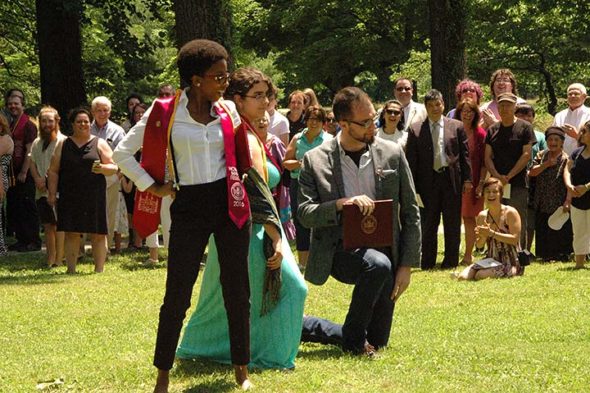
The 50 members of Antioch College’s Class of 2016, the second graduating class of the revived college, celebrated their commencement last June. Newly minted graduates Jasmine Lindquist, Sylvia Newman and Ozrich Sable crossed “the Mound” in their own dramatic ways, carrying on an Antioch tradition. (Photo by Matt Minde)
2016: Yellow Springs year in review — higher education
- Published: January 5, 2017
ANTIOCH COLLEGE
In 2016, the relaunched college welcomed its second president, celebrated its second graduating class and received accreditation from the Higher Learning Commission, while also reducing its budget and cutting jobs and salaries for the first time since reopening in 2011.

Antioch College’s new president, Tom Manley, started at the college on March 1, replacing Mark Roosevelt, who left at the end of 2015. Manley is pictured here with his wife, Susanne Hashim, in the doorway of their home, the Folkmanis House on President Street. The couple moved to Yellow Springs with their young daughter, Chedin. (Photo by Audrey Hackett)
New president arrives
New Antioch College President Tom Manley arrived on campus March 1, becoming the second president of the relaunched college. He succeeded Mark Roosevelt, whose five-year contract ended in 2015. Manley has more than 35 years of experience in higher education, most recently as president of Pacific Northwest College of Art in Portland, Ore. He and his wife, Susanne Hashim, settled with their daughter in the Folkmanis House on campus in the spring.
College graduates second class
In June, 50 members of the class of 2016 walked exuberantly over “the mound” and into Antioch history. The graduates were the second class to graduate from the reopened Antioch. The college also honored longtime staff member Anna Hogarty, who retired in June.
Green light for College Village
The Board of Trustees voted in June to launch a 32-unit cohousing pilot project as the first phase of plans for a larger multigenerational housing community on campus, called Antioch College Village. The college also announced the selection of an internationally renowned green architect for the cohousing project, Jason McLennan, founder of the Living Building Challenge.
College leaders cited the commitment of a group of Yellow Springs residents — many of whom had attended a 2015 “charrette” on the College Village — to the cohousing project as a key reason for moving ahead. The college is seeking to raise $2.2 million for planning and zoning on the larger project, while the cohousing portion will take three years and an additional $6.5 million to build. Design work on the cohousing project began this fall.
Now accredited!
After an arduous five-year process, the good news came down in July: the relaunched Antioch was now accredited. Accreditation from the Higher Learning Commission is considered essential to legitimizing a college’s programs. And the positive accreditation decision will help Antioch raise funds and attract students, according to college leaders, who hailed it as a major milestone. For the just-graduated 2016 class members, accreditation had a very tangible benefit: they now held degrees from an accredited Antioch.
New VP for advancement
Veteran fundraiser Susanne Hashim stepped into the college’s top fundraising role in August. The wife of President Manley, Hashim was hired after a two-month search that drew 30 candidates, none of whom matched her qualifications, according to college leaders. In an interview with the News, Hashim, who has over 20 years of development experience, said she planned to tap new funding sources, including foundation, corporate and community support.
Forward with FACT
The campus took part in a series of “design-build” exercises in August as part of the Framework for Antioch College Transition, or FACT, President Manley’s strategy for developing new models of financial sustainability for the college. The design-build sessions generated new ideas for using the college’s core “curricular assets” — which include Glen Helen, WYSO and the Coretta Scott King Center — to both generate revenue and enhance learning. The first ideas from that process will be funded with small grants, to be announced in early 2017.
New class smaller than hoped
Despite recruitment efforts that continued through the summer, Antioch’s incoming class in October numbered just 44 students, substantially below the 75 to 80 students the college hoped to attract. In interviews with the News, college leaders said the shortfall reflected turnover in the admissions department, lower levels of Horace Mann funding and other factors.
Students, half of whom hail from Ohio, are notably diverse: 39 percent are people of color and seven percent are transgender. Those interviewed by the News emphasized the college’s commitment to social justice as a key reason for enrolling. With the new class, the college’s total enrollment currently stands at 220 students.
Senior administrators hired
The college made three key hires in the fall, filling three senior administrator positions. Mark Reynolds, a 1980 Antioch alumnus and communications officer for the U.S. post office in Chicago, became the college’s director of communications and marketing. Bill Carter was hired as dean of admission and financial aid, bringing over 25 years of experience in higher education admissions, most recently at the University of Tennessee’s Health Science Center. And another 25-year veteran of higher education, Susan Lee, was tapped as dean of student life, having most recently directed diversity and inclusion efforts at Earlham College.
College cuts costs, jobs
In December, Antioch announced it was cutting the jobs of five employees, and the salaries of 23 other senior and executive administrators as part of an 18-month effort to reduce expenses. That effort sought to address shortfalls in fundraising, as well as unexpectedly slow growth in student enrollment and tuition revenue. The majority of the budget reduction was achieved gradually through attrition, according to college leaders. A total of 31 staff positions have gone unfilled or have been restructured since budget reduction efforts began in July 2015. The college now has 107 staff employees and 33 faculty. Faculty positions and salaries were not affected by the cuts, which were the first to be enacted since the college reopened in 2011. College leaders emphasized that the college remains viable and on a strong course.
ANTIOCH UNIVERSITY
Antioch University announced a major restructuring in mid-2016, with university leaders considering a possible sale of the AU Midwest campus. Meanwhile, Antioch University Midwest continued to expand its collaborations with area community colleges.
New workshop series
In January, AUM debuted a series of workshops exploring subjects including racism, restorative justice, gender roles, the nature of the self and spirituality vs. science. The workshops ran through June, and were a collaboration between the university’s “Victory for Humanities” event series, and Adjunct Professor Wendy Peters’ “Trail of Understanding” series, which draws on ancient wisdom traditions.
Major restructuring announced
In June, AU leaders announced a major restructuring across the university, including the elimination of the boards of trustees on all five campuses along with each campus’s president. Former Antioch University Midwest President Karen Schuster Webb, hired in late 2013, was among the five campus presidents whose positions were cut. The restructuring was taken to streamline and unify the university, as well as address budget issues, according to university leaders. One factor in the restructuring was a $8 million deficit in the university’s operational budget for the fiscal year ending in June 2016, a deficit that reflected overly optimistic enrollment projections across the five campuses.
The university’s fiduciary Board of Governors continues to oversee the entire university system, while the AUM campus is now led by Provost Marian Glancy.
Groves named interim chancellor
In another leadership change last spring, Springfield attorney Bill Groves was named the university’s interim chancellor for two years, replacing former Chancellor Felice Nudelman, who became the university’s chief global officer for innovation and partnerships beginning June 30. Groves has been affiliated with the university since 1979.
Building sale considered
In July, university leaders spoke with the News regarding the possible sale of the 94,000 square-foot AU Midwest building on the western edge of Yellow Springs, one aspect of a university-wide discussion about how to cut costs and better use the university’s physical facilities. According to university leaders, the sale was being considered for budgetary reasons and because the location no longer works well for the university’s adult students, many of whom commute from Dayton and Cincinnati. To reach students, AUM is pursuing partnerships with area institutions to offer classes in other locations. As of early December, no decision about a potential building sale had been made, according to an update from Provost Marian Glancy.
New partnerships announced
AUM announced two new partnerships with area community colleges in 2016, the first in July, with Clark State Community College in Springfield, and the second in November, with Southern State Community College in Hillsboro. Called “3+1 degree pathways,” the partnerships help students earn both bachelor’s and associate degrees in four years while saving nearly $12,000. AUM had previously announced a collaboration with Sinclair Community College, including use of that college’s Mason campus by AUM faculty, in 2015.
The Yellow Springs News encourages respectful discussion of this article.
You must login to post a comment.
Don't have a login? Register for a free YSNews.com account.













No comments yet for this article.